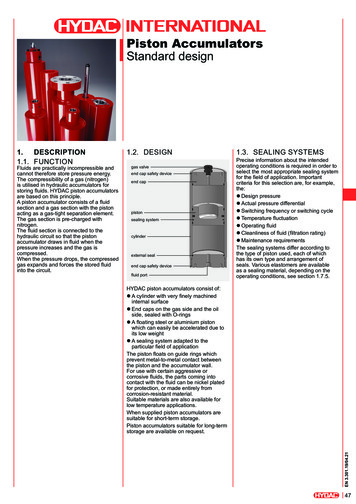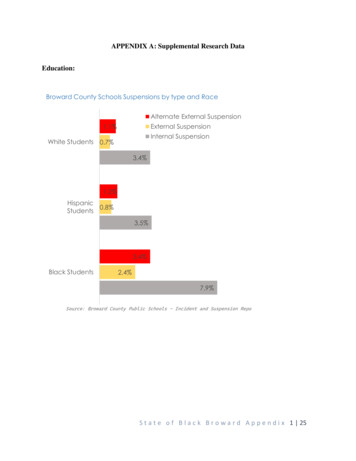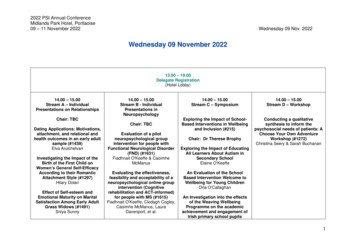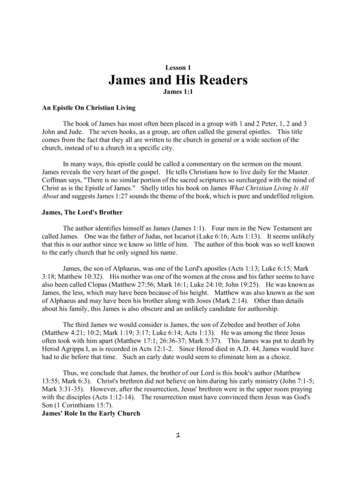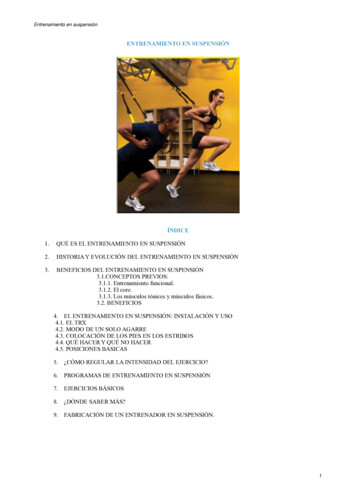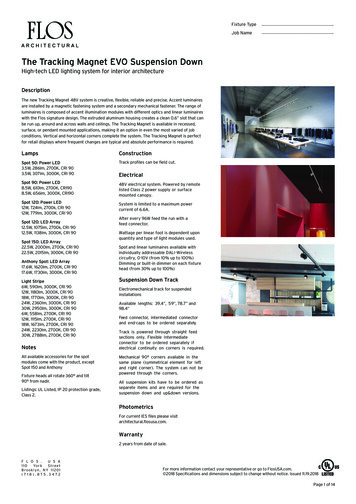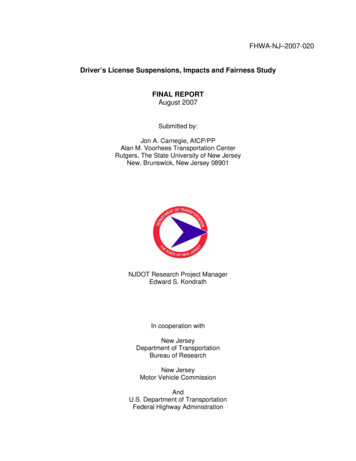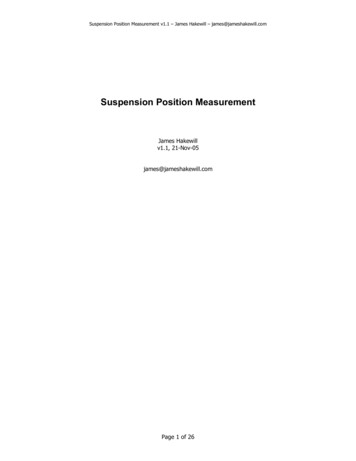
Transcription
Suspension Position Measurement v1.1 – James Hakewill – james@jameshakewill.comSuspension Position MeasurementJames Hakewillv1.1, 21-Nov-05james@jameshakewill.comPage 1 of 26
Suspension Position Measurement v1.1 – James Hakewill – james@jameshakewill.comSuspension Position MeasurementThis document is intended to describe how suspension position can be measured using a datalogging system, and how the raw data can be converted into traces for: individual wheel movementchassis movements as pitch, roll, heave and warpdynamic camber anglesMeasurementThe pictures below show a 1978 Eagle DGF Formula Ford car – this car uses rocker-arm frontsuspension and trailing link rear suspension.Rocker arm front suspensionTrailing link rear suspensionFour analog channels from the vehicle’s data logging system are required – the movement ofeach corner of the suspension is measured independently.A common method for collecting suspension movement data is to measure shock travel witheither a linear potentiometer (“shock pot”) or LVDT. These are generally mounted in-line with theshock piston rod or attached to the bellcrank in pushrod suspensions.An LVDT is a non-contact linear position transducer, where two coils move relative to each other.An interface box is usually required to connect LVDTs to a data logging system. Potentiometerscan generally connected directly to the system. Shock pots are expensive – typically 200 each,and LVDT’s are even more expensive!Page 2 of 26
Suspension Position Measurement v1.1 – James Hakewill – james@jameshakewill.comFor the Eagle suspension measurement project, rotary potentiometers (10k linear) from RadioShack are used, actuated by linkages made from radio-control aircraft hardware. Miniaturepushrods and spherical bearings are used for the linkages. The lever arm operating eachpotentiometer was originally intended as a steering arm for either a boat rudder or an aircraftundercarriage.The advantages and disadvantages of this rotary-pot setup – when compared to motorsportquality shock pots are as follows: Advantageso Cost – excluding the connectors for the data logging box, the total parts bill wasunder 30o No modifications were required to the shocks – all brackets take advantage ofexisting suspension bolts and pickups.o The pots can be mounted out of the airflow (and thus away from flying rocks) –an important consideration on a car with outboard suspension.o It is not necessary to remove the shock pot to change springs Disadvantageso Linkage operating a rotary pot will introduce a small amount of non-linearity intoshock travel measurement. This can be factored into the sensor calibration,considered when creating math channels from the raw data, or just ignored.o Sealed potentiometers should be used for reliability and operation in wet weather– an attempt to seal the pots with duct tape and silicone was made.o Radio Shack pots are not the highest quality – a long life is not expected Higher quality sealed pots would be a better choice Wire-wound pots should tolerate more cycles before failure, but due totheir construction, do not have the same resolution as a conductiveplastic potMeasurement accuracyThe pots are connected as voltage dividers – giving an output between 0v and 5v – proportionalto the rotation of the shaft around the 270-degree sweep. In order to limit non-linearity inmeasurement, the linkages are arranged in order to have the full suspension movement result ina rotation at the pot of around 45-60 degrees. As a result, only a small portion of the totalmeasurement range is being used.We can do a quick calculation to work out the minimum displacement that can be measured.The AIM EVO3 data logging system contains analog-to-digital converters (ADCs) with 12-bitaccuracy and input range of 0-5v. An input of 0v corresponds to a raw value of 0, a full-scaleinput of 5v will result in a full-scale output of 212 –1 4095. Thus each output step correspondsto an input change of 5/4096 0.00122 voltsIf we assume a 45-degree movement with a 270-degree pot, the change of output from fulldroop (0) to full bump (4095) will be: 4096 * 45/270 683.If the total wheel movement corresponding to a 45-degree movement at the pot is 5 inches, thenthe smallest measurement step is 5 / 683 0.007” or 0.2mm of wheel movement.For a car with a 57” track, this corresponds to a minimum roll measurement of 0.008 degrees.Page 3 of 26
Suspension Position Measurement v1.1 – James Hakewill – james@jameshakewill.comThis seems like a reasonable degree of accuracy to get an idea of suspension position around thetrack. However it would likely not be accurate enough for critical measurements of ride height foroptimization of aerodynamic devices such as front wings, splitters or diffusers.Sample frequencyThe data to be collected will be used for analysis of roll, pitch and heave – fairly slow-speedchanges. As a result, data is collected at 50Hz - a reasonable rate for vehicle parameters.When collecting data for analysis of shock valving, it would typically be necessary to use a muchhigher sample rate in order to capture high-frequency inputs. It is also likely that a much higherdegree of measurement accuracy would also be required.Sensor calibrationThe linkages were designed such that the movement of the wheel from full droop to full bumpwould correspond to 45-60 degrees of movement at the potentiometer. The potentiometer leverarm positions and pushrod lengths are set so that when the car was at static ride height withdriver aboard, the pushrod meets the lever arm at 90 degrees.To calibrate the suspension channels, the following procedure is followed: Set all suspension input channels to the logger as 0-100% potentiometers With the springs and shock bumpstops removed, and roll bars disconnected, calibrateeach channel: Set 0% full droop – maximum extension of shock absorber Set 100% full bump – maximum compression of shock absorberA second step is used to get the static ride height information: With the springs and bumpstops back in place, The car is placed on flat and level ground (e.g. scale platform) with the driver aboard A laptop is connected to the logger and set to display the live suspension position data The value for each corner at static ride height is noted This value is used later as a reference value to determine bump and droopOn this type of car, the positions of the shock absorbers at static ride are almost always slightlydifferent from side to side – as a result of the spring seat adjustments required to equalize cornerweights.In order to calculate wheel movement, we do of course need to know the relationship betweenshock movement and wheel position. This will either be represented by constant scaling value orby an equation for rising-rate suspension.It would have been possible to calibrate the sensors for inches or mm of wheel movement (orshock movement) either side of static ride height. The sensor calibration scheme above waschosen to allow for rapid calibration (and recalibration) - without requiring that the calibrationstep include a measurement of shock position at static ride height. It also allows ride heightchanges to be made without needing to remove the springs to recalibrate the pots – it is onlynecessary to note the suspension position values after changing ride height.Page 4 of 26
Suspension Position Measurement v1.1 – James Hakewill – james@jameshakewill.comVehicle data required for basic calculationsFor the basic calculations of ride height, roll, pitch and heave, we will need: Suspension travel at wheel from full droop to full bump – front and rearRelationship between wheel movement and shock pot movementWheelbaseTrack – front and rearFront/rear weight distributionReference values for each shock channel at ride heightThe table below shows the measurements used for the Eagle Formula Ford.MeasurementVertical movement at wheelMovement at shock (stroke length).hence motion ratioTrackWheelbaseFront/Rear weight distributionRising rate?Shock channel value at rideFront127 mm64mm0.51141 mmRear114 mm80 mm0.71391 mm2430 mm42% front, 58% rearNo - wheel travel and shock travel are linearNote the value reported for each cornerwheel – full bumpchassismotion rangeat wheelgroundwheel – full droopPage 5 of 26
Suspension Position Measurement v1.1 – James Hakewill – james@jameshakewill.comVehicle data required for dynamic camberFor dynamic camber calculations, it is necessary to know how camber changes as the wheelmoves up and down in roll or bump. This data can be obtained either by direct measurement, orby taking many measurements of suspension components and pickup points, and by using asuspension geometry program such as WinGeo.On the whole, as a wheel moves into bump, the camber becomes more negative – the schemebeing to counteract chassis roll during cornering. This is called ‘camber recovery’.Camber Curves - Eagle DGF Formula Ford0-60-40-2002040-0.5Camber (deg)y -0.0002x 2 - 0.0267x - 0.8846-1-1.5-260The data usedhere for the EagleFormula Ford wasmeasured directlyfrom the vehicle –and the curves areshown in the chartbelow. Note frontand rear staticcambers (at zerobump) were set to–1.2 and –0.8respectively.From the chart itcan be seen thatthe camber curvesy -1E-04x 2 - 0.0238x - 1.2065are indeed curves-3and not straightBump (mm)lines. A secondorder polynomialFrontRearPoly. (Rear)Poly. (Front)equation for thecurves has beenextracted by using a handy feature of Microsoft Excel. When data is plotted, it is possible to adda “trendline” (linear or polynomial) and display the equation on the chart.-2.5The equations for camber gain with bump are therefore:Fcamber ( 0.0002 * bump 2 ) 0.0267bump FstaticamberRcamber ( 0.0001bump 2 ) 0.0238bump RstaticcamberThe camber curves for the Eagle were measured along with the shock and roll bar motion ratios,using the following procedure – very similar to that used to measure bump steer: Remove the springs and any shock bumpstops, or remove shock/spring assembliesDisconnect anti-roll barsSet the car on a flat and level surface on ride height blocksAttach bump steer plate (e.g. Longacre 7905) to one cornerInsert steering rack locks to prevent steering whilst the suspension is movedSet the brakes to prevent rotation of the plate whilst the suspension is movedSet the suspension at ride height using a jackPage 6 of 26
Suspension Position Measurement v1.1 – James Hakewill – james@jameshakewill.comThis can be done either by fitting a wheel and measuring the distance from somepoint on the hub to the groundo Or by setting the suspension to a known shock displacement – either by directmeasurement, or by using the shock pots and laptop displayMeasureo Camber - from the bump steer plateo Shock displacemento Anti-roll bar displacementRaise the suspension using the jack in ½” steps (or your chosen interval) and repeatmeasurements until full bump is reachedReset the suspension to ride height, repeat measurements at ride (for cross-check)Lower the suspension in ½” steps until full droop is reachedRepeat for other end of carRepeat for other side of car for cross-checko Measuring camber curve, motion ratio and bump steer on a Van Diemen RF00Page 7 of 26
Suspension Position Measurement v1.1 – James Hakewill – james@jameshakewill.comCalculationsNow that the car has been measured and the sensors calibrated, it’s time to go out on the trackand have some fun – and collect some suspension data while we’re at it.The picture above shows the Eagle at the apex of turn 9 at Laguna Seca, on the downhill runaway from the Corkscrew – as seen from the roll hoop of John Major’s Swift DB6.In the calculations below, the channels are names as follows. Where there are four channels foreach corner, only the left-front (LF) channel is shown. It is assumed that the other three cornersalso exist (RF., LR., RR.).ChannelLFshockTypeMeasuredDescriptionLeft front shock position Left front shock position at ride height (noted during setup)Left front motion ratioLeft front shock stroke (fully extended to fully closed), in mmLeft front vertical travel (full droop to full bump), in mmLeft front static camber at ride heightFront track in mmRear track in mmPercentage of weight on front athMathLeft front dynamic bump at wheel, either side of ride, in mmCamber change due to bump travelFront axle roll ( ve in left hand turn)Rear axle rollRoll at CGPitch angle ( ve when nose-up)Vertical motion of chassis a.k.a heaveVertical motion of chassis at frontVertical motion of chassis at rearPage 8 of 26
Suspension Position Measurement v1.1 – James Hakewill – james@jameshakewill.comCalculation of shock positionIndividual shock positions either side of the static ride position are calculated as follows: Subtract shock position at static ride from shock position channel, to get movementeither side of static ride height, as a percentage of total shock travelo ve bump, -ve droop Multiply by shock stroke (a constant), to get movement at the shock in mmLFshockbump ( LFshock LFride)*LFshockstrokeCalculation of wheel positionIndividual wheel positions either side of the static ride position are calculated as follows: Divide shock position in mm by motion ratio to get movement at the wheel in mmo This step would be more complicated with a rising-rate suspension!LFbump LFshockbumpLFmotionratioIt would of course be possible to avoid the step of calculating the shock position in mm – but itmay prove useful later – for example to calculate shock piston velocities.Page 9 of 26
Suspension Position Measurement v1.1 – James Hakewill – james@jameshakewill.comCalculation of vertical movementsBy SAE convention, positive vertical movement of the chassis is downwards – the wheels are inbump.vertical 0c.gvertical 0c.gIt is useful to calculate vertical movement of the chassis at each end of the car, to understandchanges in dynamic ride height. Note that this is the change in ride height at the centerline of thecar.Fvertical LFbump RFbump2Rvertical LRbump RRbump2Vertical movement of the chassis at the center of gravity can be calculated as follows:vertical ( Fvertical * Fweight ) ( Fvertical * (1 Fweight ))2Page 10 of 26
Suspension Position Measurement v1.1 – James Hakewill – james@jameshakewill.comRoll angleBy SAE convention, positive roll is experienced in a left-hand turn – where the right side is inbump ( ve), and the left side is in droop (-ve).leftrightroll 0trackroll 0droopbumpUsing the right-angle triangle formulae (sin-cos-tan oh heck another hour of algebra)ohasin A Aohcos A ahtan A oaWe can calculate the angle that the wheels make relative to the chassis, and assume that if thewheels are on the ground, this must also be the chassis roll angle: RFbump LFbump Froll arctan Ftrack RRbump LRbump Rroll arctan Rtrack We can split the difference between the two roll numbers to get a figure for roll at the center ofgravity:roll ( Froll * Fweight ) ( Rroll * (1 Fweight ))At this point, it seems sensible to ask how a supposedly rigid frame can have a different rollangle at the front and rear end. Remember that we can only measure the angle that the wheelsmake with the frame, and not the angle that the frame makes with the ground. Differences in rollangle front to rear could be attributed to: The car won’t be traveling on a perfectly smooth trackThe front and rear tires will deform differently – from different vertical loads (anddifferent tire construction and pressure leading to different tire spring rates)The frame isn’t going to be completely rigidPage 11 of 26
Suspension Position Measurement v1.1 – James Hakewill – james@jameshakewill.comCalculation of pitch angleBy SAE convention, positive pitch is a nose-up attitude – with the front end in droop, and therear end in bump.pitch 0c.gpitch 0c.gAt each end of the car, we split the difference between the bump travel of the left and rightwheel, to get a single number for vertical movement of the wheel pair relative to the chassis atthe centerline. The angle made relative to the chassis between the front and rear wheel pairs istaken as the pitch angle.The pitch angle can be calculated as follows: Rvertical Fvertical pitch arctan wheelbase Page 12 of 26
Suspension Position Measurement v1.1 – James Hakewill – james@jameshakewill.comDynamic camber angleWe can use the combination of wheel movement data, chassis roll and the camber curves tocalculate numbers for dynamic camber of each wheel.Using the camber equation and the individual wheel bump data, we can calculate the camberangle that would be measured at the wheel if the chassis were level.staticFor example, using the camber equation for the Eagle’s front suspension, we can work out thecamber change due to bump travel:LFcamberchange ( 0.0002 * LFbump 2 ) 0.0267 LFbumpWe actually want to know the dynamic camber relative to the track and not the chassis – so wemust factor in the chassis roll number.dynamicleftrightStarting with the static camber at ride height, we calculate dynamic camber as follows. Note thatas the camber angles are measured relative to the chassis, we must treat left and rightdifferently. For example, for the front end:LFcamber LFstaticcamber LFcamberchange rollRFcamber RFstaticcamber RFcamberchange rollIn the diagram above, the car is making a turn to the left, and thus is experiencing a positive rollangle. The RF wheel has moved into bump, and the suspension will be adding negative camber(RFcamberchange will be negative). The LF wheel is in droop, so LFcamberchange will bepositive. The effect of the positive chassis roll is to make the right side camber more positive andthe left side more negative.Page 13 of 26
Suspension Position Measurement v1.1 – James Hakewill – james@jameshakewill.comAIM math channel definitionsThe table below shows the settings used to create math channels for the Eagle Formula Ford –using AIM Race Studio Analysis lmmmmmm-100-100-100100100100(LFbump RFbump)/2(LRbump RRbump)/2(Fvertical Rvertical)/2Frolldeg-1010Front track )/DEG2RAD(Froll*0.42) DLFcamberchangedeg-1010See camber RRcamberchangedeg-1010(-0.0002*LFbump 2)(0.0267*LFbump)(-0.0002*RFbump 2)(0.0267*RFbump)(-0.0001*LRbump 2)(0.0238*LRbump)(-0.0001*RRbump egdegdegdeg-10-5-10-510151015-1.6 LFcamberchange-Froll-1.6 RFcamberchange Froll-0.8 LRcamberchange-Rroll-0.8 RRcamberchange Rroll-1.6-1.6-0.8-0.8All channels are sampled at 50Hz.Page 14 of 26Rear track 1391mmFront weight 42%Wheelbase 2430mmSee camber curvesSee camber curvesSee camber mber
Suspension Position Measurement v1.1 – James Hakewill – james@jameshakewill.comData interpretationThere is surely a great deal that can be learned from the suspension data – and a great deal ofpossible confusion as well. In previous sections we have seen how to calculate a number ofuseful vehicle parameters. These equations can be used in either a spreadsheet package likeMicrosoft Excel, or defined as math channels in your favorite data logging analysis package.The data shown here was collected over the course of one three-day weekend at InfineonRaceway (Sears Point) in Sonoma, CA. The top-view map is shown on the left, another map withelevation on the right.T3/3aT2T11T5T1T7T6T9T10T4T8/8aFrom the maps it can be seen that Infineon has avariety of different turns and plenty of elevationchange. The section from turn 7 through to turn 11 isparticularly fun!Before we get into the data analysis, take a moment to compare the basic data logging traceswith the maps above.SpeedLat GLong23/3a4678/8a10A positive lateral G trace indicates a left turn – negative is a right turn.A positive longitudinal G trace indicates forward acceleration – negative is braking.Page 15 of 2611
Suspension Position Measurement v1.1 – James Hakewill – james@jameshakewill.comIndividual wheel movementsThe chart below shows an entire lap with the wheel movement (bump) data – relative to staticride height positions. Bump is shown as a positive number, droop as a negative 4678/8a1011Apart from expressing sheer horror at the complexity of the chart, we can recognize a number ofclear trends in the whole-lap trace: During pure cornering (no braking), the left and right traces are not far off being mirrorimageso Take the section between turns 8 and 10 - when turning left, the right wheelmoves into bump, the left wheel moves into droop (and vice versa) During hard straight-line braking, both front wheels go into bump, and both rear wheelsgo into droopo For example the longest braking zone on the track is between turns 10 and 11 The traces are very noisyo Compared with the lateral and longitudinal G traces, there are lots of tiny spikesand a number of very big ones. And finally - it’s not immediately clear what is happening to the car!Page 16 of 26
Suspension Position Measurement v1.1 – James Hakewill – james@jameshakewill.comSpeed1 23 4 5The segment on the left shows turn 11 indetail. This is a fairly straightforward slowspeed hairpin corner (nearly 180 degrees),which can be split into five sections:1. Hard straight-line braking startsfrom high speed.LatG2. Straight-line brakingLongG3. Turn-in, still on the brakes4. Cornering, on the throttleLFbump5. Corner exit, on the throttleWe can look at each segment one at a time.RFbumpSegment 1 and 2 – The LongG trace showswhere braking starts. From the wheel tracesit can be seen that all four wheels show alarge movement in bump immediately priorto braking. This is actually due to a bump inthe track – which makes a great brakingreference for turn 11.Note that the rear wheels see the bumpslightly later than the fronts – we will look atthis in more detail later.LRbumpRRbump11After braking starts, both front wheelsrebound from the bump but stay much more compressed than before braking began. The grayline for each wheel shows the static ride height position. The rears also rebound, but much morethan the fronts, and stay more extended than before braking started. In other words, the nose ofthe car dives, and the rear comes up. Weight is transferred to the front end.Segment 2 - During the braking zone all four wheels seesome up and down movement, but around a stableaverage. The front end is still compressed, the rear endextended. But – is the up and down movement in thebraking zone due to bumps or some kind of oscillation?The longitudinal G trace does not suggest big changes inbraking pressure.Looking at the braking zone in detail, we can see that therear trace (below) is very similar to the front but slightlydelayed. The cursor shown is at 11073.9ft, thecorresponding peak on the rear trace is at 11081.9ft –suggesting a difference of about 8ft. The accuracy ofdistance measurements with the logger is not all that great, but each of the other peaks showsimilar distances of around 8ft. The wheelbase of the car is 2430mm 95.7”, or 7ft 11.7”. So wecan be fairly safe in assume that these are bumps or undulations in the track. By looking at thetraces, we can take a guess at which are single-wheel bumps and which affect both sides of thecar.Page 17 of 26
Suspension Position Measurement v1.1 – James Hakewill – james@jameshakewill.comSegment 3 – Turn-in happens whilst still braking. Whether this is the best way around the corneris open to question – but we can see that the lateral G increases whilst longitudinal G still showsbraking. The most significant wheel movements are on opposite corners of the car – the right(inner) front, and the left (outer) rear – on turn-in, the RF wheel rebounds, and the LR wheelgoes into bump. The LF wheel shows a little movement in bump, and the RR wheel shows a littlein rebound. Hence as the car turns right, the chassis moves from nose-down into a roll to theleft. Weight is transferred to the left side.Segment 4 shows a short section of cornering – the lateral G trace is at a stable value. Thelongitudinal G trace goes positive, indicating that the driver is getting on the throttle andaccelerating. During this segment, both front wheels move into rebound and both rears staycompressed – the chassis is still in roll, but the front end is coming up as a result of theacceleration. Weight is transferred towards the rear.Segment 5 shows corner exit – the lateral G trace reduces and the longitudinal G shows stableforward acceleration. The chassis is now de-rolling – LF and LR move into rebound, RF and RRmove into bump.From these observations, we can put together a table summarizing the wheel and shockmovements, from which we can draw some conclusions about how shock changes might affectthe handling:CornerNameLFRFLRRRMore u/sSegment 1Initial brakebumpbumpreboundrebound-Segment 2Braking-Segment 3Corner entryreboundbumpreboundF rebound R bump –Segment 4CorneringreboundreboundF rebound -More o/s--F rebound R bump F rebound Segment 5Corner exitreboundbumpreboundbumpF bump F rebound R bump R rebound F bump F rebound R bump R rebound -This table could also be extended to include the effect of changing springs and bars.From the wheel movement channels, it is possible to visualize the movement of shocks and thepossible adjustments – but it is difficult to see what is happening to the attitude of the chassis asa whole.Page 18 of 26
Suspension Position Measurement v1.1 – James Hakewill – james@jameshakewill.comRoll, Pitch, Vertical movementThe chart below shows the same lap as before – but this time the individual wheel motion traceshave been replaced with roll, pitch and vertical motion traces – calculated using the equationsdescribed a1011There are two strikingly obvious features about this chart: The chassis roll trace is almost identical to the lateral G trace The pitch trace is almost identical to the longitudinal G trace There is a lot of noise on the pitch and vertical traces, but much less on the roll traceAnd one obvious-when-pointed-out feature: The vertical trace (positive means chassis downward motion, or all wheels in bump)tends to be positive when going starting to go uphill (e.g. turn 1, turn 3), and negativewhen starting to go downhill (e.g. entry to turn 6).Page 19 of 26
Suspension Position Measurement v1.1 – James Hakewill – james@jameshakewill.comSpeed12 3 4 5The segment on the left shows turn 11 in detailonce again – but this time using the roll, pitch andvertical motion traces. The corner is divided intofive sections as before:1. Hard straight-line braking starts from highspeed.LatG2. Straight-line braking3. Turn-in, still on the brakesLongG4. Cornering, on the throttle5. Corner exit, on the throttlerollOnce again, we can look at each segment one ata time.Segments 1 and 2 – The LongG trace showswhere braking starts. The pitch trace showspitchimmediately that the front end dives – or the rearend rises. The individual wheel motion orFvertical/Rvertical traces must be consulted to tellwhich. The vertical trace shows a large movementimmediately prior to braking. This is the bump inverticalthe track – notice that the vertical trace showswhat appears to be up-down oscillation after thebig bump during the braking zone. It is not clear11from this trace or the wheel traces if this is trackbumps (most likely) or undamped oscillation. There is no significant roll motion.Segment 3 – Turn in. The longitudinal G and pitch traces show that the driver is still on thebrakes – the nose is still down as the lateral G and roll increase.Segment 4 – Power application and cornering. As power is applied, we can see that the car goesfrom nose-down to nose-up very quickly, without any significant change in roll or verticalmovement.Segment 5 – Corner exit. As the car exits the corner, pitch and vertical motion remain largelyunchanged as the car de-rolls.Notice at the very right hand side of the picture is a large spike on the pitch and vertical traces –this is due to a gearshift. Presumably a faster shift would cause less disruption.From this set of traces it is much easier to visualize the motion of the chassis, and seedisruptions on a single channel – however visualizing what is happening for shock adjustments ismore difficult.Page 20 of 26
Suspension Position Measurement v1.1 – James Hakewill – james@jameshakewill.comRoll trace correlationIn order to see how well the roll and lateral G traces correspond, we can create a scatter plot – inthis case using Microsoft Excel.The chart plots the front and rear roll channels, plus the ‘roll at center of gravity’ channel againstlateral G – for every captured data point during one lap. It is clear that the correlation betweenroll and lateral G is very strong and very linear. We can also see that the front and rear rollnumbers are very similar.The equations for the linear trendlines are shown on the chart – with c.g. roll in bold type. T
extracted by using a handy feature of Microsoft Excel. When data is plotted, it is possible to add a "trendline" (linear or polynomial) and display the equation on the chart. . Reset the suspension to ride height, repeat measurements at ride (for cross-check) Lower the suspension in ½" steps until full droop is reached
